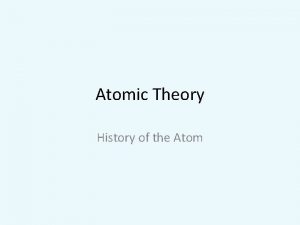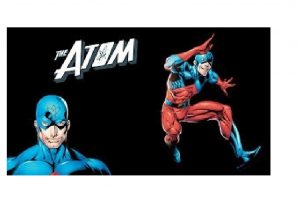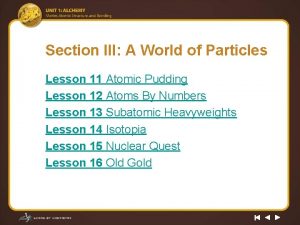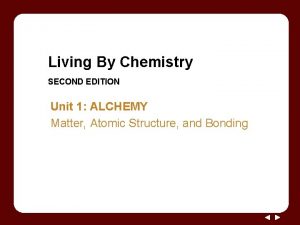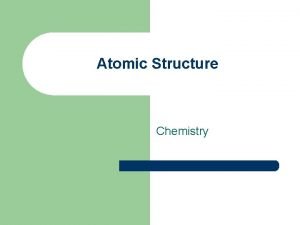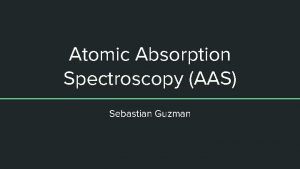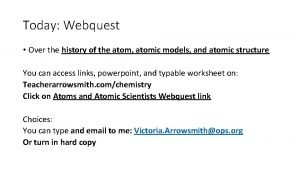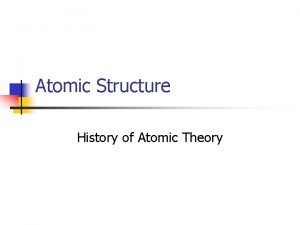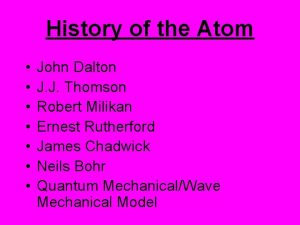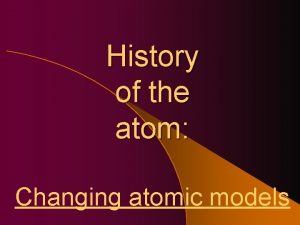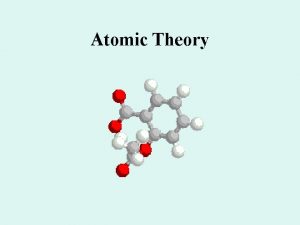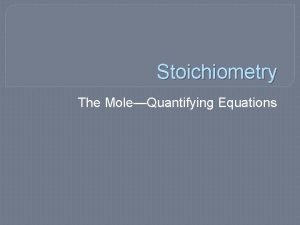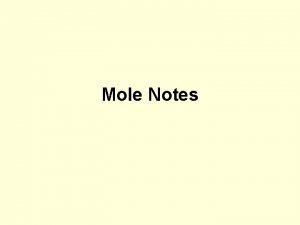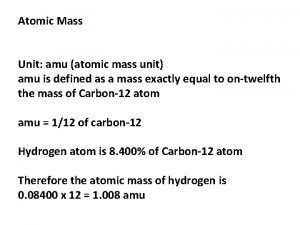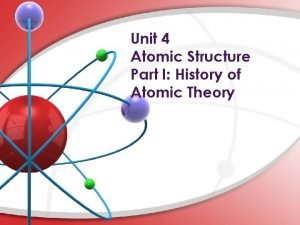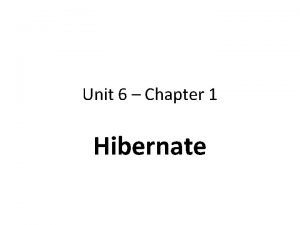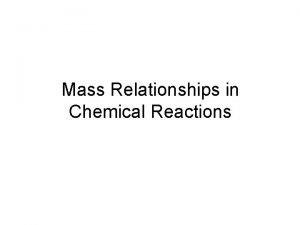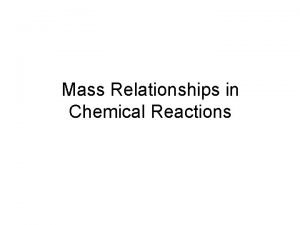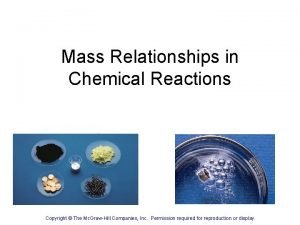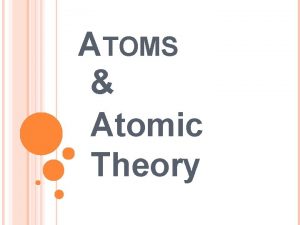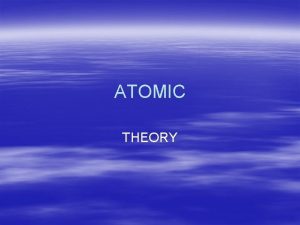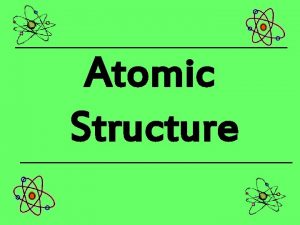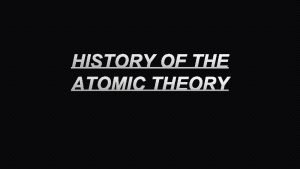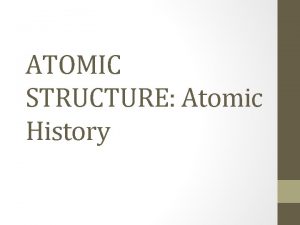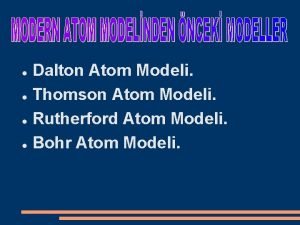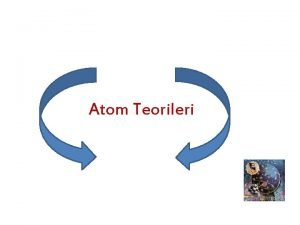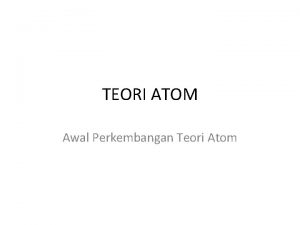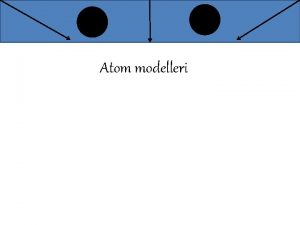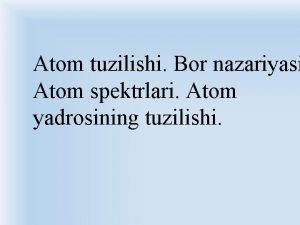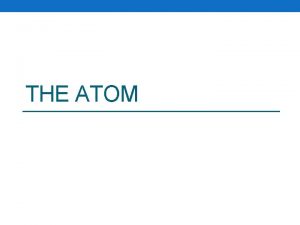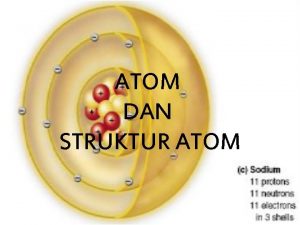Unit 3 Atomic Theory History of the Atom





























- Slides: 29

Unit 3: Atomic Theory

History of the Atom • Democritus Greek Philosopher around 400 B. C. was the first to consider the atom; he said that all matter would never disappear so these particles had to exist He named them Atomos • Atoms are tiny individual particles that have their own characteristics.

The Dalton Model/Postulates • Proposed the 1 st Atomic theory in 1800’s • 1. All elements are made up of tiny indivisible particles called atoms. • 2. Atoms of the same element are identical. The atoms of one element are different from the atoms of another element. • 3. Atoms of different elements chemically combine to form chemical compounds. • 4. During chemical reactions, atoms are rearranged. Atoms of one element cannot be changed into atoms of a different element as a result of a chemical change.

The new theory leads to discovery of new laws. • Law of Conservation of Mass: which states that mass is neither destroyed nor created during ordinary chemical reaction or physical change. • Law of definite proportions: A chemical compound contains the same elements in the same proportions by mass regardless of the size of the sample.

Laws continued • Law of multiple proportions: If two or more different compounds are composed of the same two elements, then the weight of the first is in proportion to the second element. • Example: CO • 1 to 1 CO 2 CO 3 1 to 2 1 to 3

Cathode Rays and Electrons • J. J. Thomson • (Thomson was awarded the Nobel Prize in 1906 for his "discovery" of the first sub-atomic particle; the electron. )

Robert Millikan’s Oil-Drop Experiment (1909) Discovered the mass to charge ratio of the electron ( how much negative charge there is for the mass of the electron)

Ernest Rutherford (1911) • 1 st one to challenge Dalton’s Model • Proposed that atoms are not dense, but rather have a dense nucleus and mostly empty space • Designed the gold foil experiment • Called his model the Plum-pudding model

Gold Foil Experiment

Rutherford’s Revised model • Prediction Model before experiment • Model after experiment

James Chadwick • He discovered the neutral particle we know as the neutron in 1932. • Won Noble Prize for it in Physics in 1935.

Niels Bohr • Proposed the orbital model for the atom in 1913. • He said that the atom has individual particles in the nucleus (nucleons) • Also, electrons roam around the nucleus in specific patterns called orbitals or shells

Energy Levels and Electrons • According to Niels Bohr, each energy level has a certain number of electrons • #e- = 2 n 2 ; where n = energy level – 1 st Level – 2 electrons – 2 nd Level – 8 electrons – 3 rd Level – 18 electrons – 4 th Level – 32 electrons – *5 th Level and on… -- 32 electrons per level

The Modern View of Atomic Structure Erwin Rudolf Josef Alexander Schrödinger was an Austrian physicist that wrote a number of fundamental equations that results in the field of quantum theory, which formed the basis of wave mechanics and the modern view of the atom. Father of Modern Atomic Theory. He worked along with Heisenberg

• Atomic mass unit (amu) – 1/12 of the mass of a 12 C – 1. 66054 10 -24 g • Size: 1 -5 Å (10 -10 m) Electron Cloud Model

Atoms are made up from: • Proton -A positively charged particle (+) (Rutherford) • Neutron - A particle that has no charge (0) (Chadwick) • Nucleus - Contains protons and neutrons (Rutherford) • Electron - A negatively charged particle that rotates around the nucleus in an area called the electron cloud. Orbitals are referred to as shells. (Thomson, Millikan, Bohr)

Atomic Number and Mass • The ATOMIC NUMBER is the number that each element is given and where you find it on the periodic table. • It is also the number of protons in the element and the number of electrons (when the element is neutral). • The MASS NUMBER is determined by the number of protons and neutrons. In AMU’s ( Atomic Mass Units) • Note: You can identify the atomic number in any periodic table as it is the smallest number of the two listed.

Atomic Mass (Average) • The Atomic mass is the average weight of each element. • It is determined by the sum of the mass of each isotope of that element that have been multiplied by their relative abundance. • Relative abundance is the percent abundance divided by 100. (decimal form of the percent)

Atomic Mass Continued • Ex. 50. 54% of the naturally occurring isotopes of bromine have an atomic mass of 78. 92 (Br-79) while 49. 46% of the rest naturally occurring isotopes of bromine have an atomic mass of 80. 92 (Br-81). • Calculate the average atomic mass of bromine, showing all work: • Ave. At. Mass = [(0. 5054)x(78. 92)]+ [(0. 4946)x(80. 92)] = 79. 91 amu

Atomic Mass Continued *Notice that the percent gets turned into relative abundance by dividing by 100, also all of the percents from all of the isotopes add up to 100% or 1 for relative abundances


Atomic Symbol H 2 e Atomic mass = Neutrons + Protons 4 Element symbol Atomic Number = Protons and also electrons in a neutral element

Isotopes • Isotopes are formed from the same element , but different atomic weight. Each contain a different number of neutrons • Example: Iodine-131 has 53 protons and 78 neutrons. The original element has 53 protons and 74 neutrons.

Isotopes (continued) • Isotope notation – Two forms: • Name – Mass • Symbol – Mass • Ex. – Potassium – 40 (19 protons, 19 electrons, 21 neutrons) – O – 17 (8 protons, 8 electrons, __ neutrons)

Ions • Ions are formed when electrons are added or removed from a neutral element. • Positive ions are formed by removing electrons • Negative ions are formed by adding electrons

Ions (continued) • Ex. – O-2 means 2 electrons have been added to a neutral oxygen atom. (8 protons, 8 neutrons, 10 electrons) – K+1 means 1 electron has been removed from a neutral Potassium atom. (19 protons, 20 neutrons, __ electrons)

A and Z • The Atomic number (Z) is equal to the number of protons in that element. • The number of neutrons plus the number of protons equal the mass number. (A) • Find the mass number of Oxygen • Oxygen is element 8 that means 8 p +8 n= 16 amu’s.

How atoms are composed

How an Atom Looks Electron(-) Proton(+) neutron(0) nucleus
 How many protons does oxygen have
How many protons does oxygen have Atomic model timeline project
Atomic model timeline project Relative atomic mass of beryllium
Relative atomic mass of beryllium Periodic trneds
Periodic trneds Atomic radius in a periodic table
Atomic radius in a periodic table Abundance calculation chemistry
Abundance calculation chemistry Atomic mass and atomic number difference
Atomic mass and atomic number difference Atomic number vs atomic radius
Atomic number vs atomic radius The atom family atomic math challenge
The atom family atomic math challenge Lesson 11 atomic pudding models of the atom
Lesson 11 atomic pudding models of the atom Atomic alchemy
Atomic alchemy The structure of the atom section 2 defining the atom
The structure of the atom section 2 defining the atom Kelemahan teori atom dalton
Kelemahan teori atom dalton Plum pudding model
Plum pudding model Atomic absorption spectroscopy history
Atomic absorption spectroscopy history Atomic structure webquest
Atomic structure webquest Unit 6 review questions
Unit 6 review questions History of the atom scientists
History of the atom scientists History of the atom john dalton
History of the atom john dalton Teori atom democritus
Teori atom democritus John dalton billiard ball model
John dalton billiard ball model Atomic structure graphic organizer
Atomic structure graphic organizer Amu vs molar mass
Amu vs molar mass Atomic weight units
Atomic weight units Carbon amu
Carbon amu Dalton atom modeli
Dalton atom modeli Hibernate introduction
Hibernate introduction Define the atomic mass unit
Define the atomic mass unit Atomic mass unit
Atomic mass unit What is amu
What is amu
